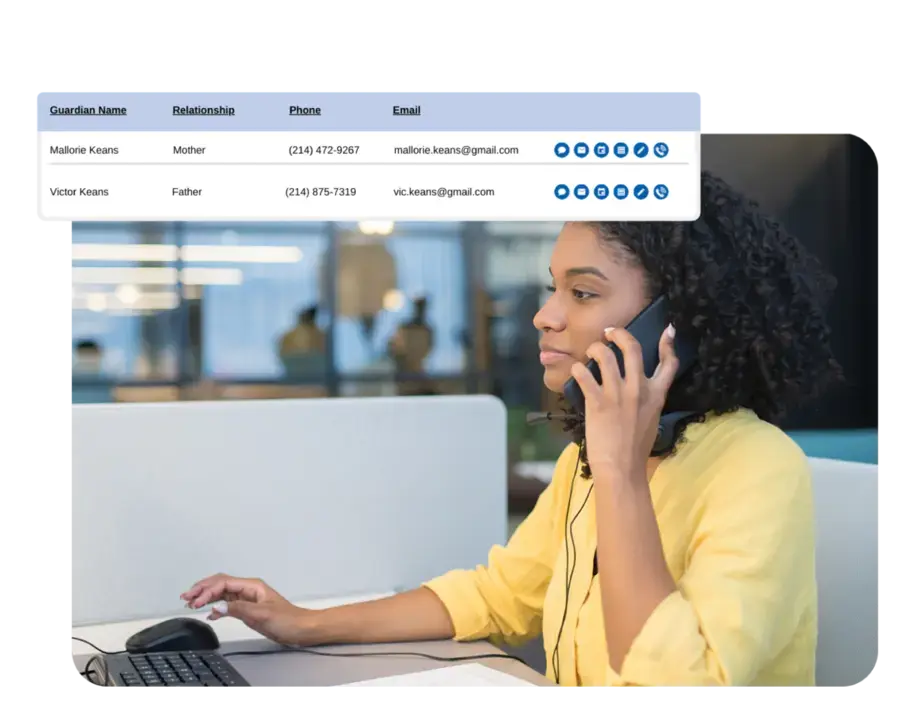The ultimate guide to growing and managing your childcare waitlist
With Free Email Templates

Collect the Relevant Data
It’s important to keep your waitlist up to date with relevant contact and family information so that you can keep parents engaged with your centre until their start date.
Aside from basic contact information (name, address, email, phone,) record data about their child, his or her age, any special needs, their requested care schedule, and any other important remarks. This will help you later when spaces open up and you need to prioritise your list. Get information about what areas of development the child needs improvement or special attention. With this information, you keep the family engaged while they’re on the waitlist by sending them personalised information.


Be Transparent with Families
Ensure parents on your waitlist are informed by being open about your policies. Consider addressing the following questions upfront:
Waitlist Fees: Are their costs either to apply, register, or join the waitlist?
Enrolment Periods: Can families apply and/or enrol at any time of year or are there designated enrolment and start dates?
Waitlist Order: Where is each family in your list? How does the waitlist order work?
Communication: What is the best point of contact for families to reach you?
Enrolment Offers: Do you offer special pricing at various times throughout the year? Can parents change their start date?
Touchbase Often
Check-in once a month with your waitlisted families via phone, email or text to make sure they’re still interested in your centre and have not decided to enrol somewhere else.
Lead Nurture Campaigns
Parents have more choices than ever before about where to enrol their child for care. Many families inquire for care with 5-7 different centres, book tours with 3-4, and then contemplate between 2-3.
It’s essential that you stay top of mind with waitlisted families as they could still be looking for care in other areas. Send long-term nurture emails at regular intervals to maintain their interest and keep them excited about enroling at your centre.
These emails should be personalised to help establish that interpersonal connection. This means that they need to include the parent’s name and/or child’s name either at the beginning of the email or within the body text. Additionally, only age-appropriate content should be shared with the family. For example, refrain from sending an email with a link to an article about toilet training to a family with a newborn. Instead, share that email with a parent whose child is aged 18-24 months.
Start with 2-3 emails in their first week on your waitlist. This ensures that they feel in touch with you and don’t feel forgotten after they agree to be on the waitlist. Then, you can begin to make the emails less frequent.
From 2-3 times in the first week, you send 1-2 in the second week. By the third week, you can move to one a week. Ideally, the longest you would wait between each email is 10 to 14 days. You should also consider sending quarterly newsletter emails.
In terms of what you should be sending, regular long-term nurture campaigns share:
• Tips (ex: ‘The importance of socialisation in toddlers’ )
• Facts (ex: ‘Why do newborns get jaundice?’)
• How-to’s (ex: ‘How to encourage your child to share’)

Other ideas of content you can share with waitlisted families:
Testimonials: Gather quotes or happy stories from families in your centre using a survey and share the positive results with your waitlist. One of the best ways to get started is by using any online reviews that you have received from parents already. Check sources like Google, Yelp, and Facebook for positive feedback to share with your audience.
Children’s learning at home: Share stories about children bringing their learning to their homes and expanding their experiences with their families. This is a perfect story if a family is wondering how children develop and grow for the child's next stages in life, especially in big school.
Talk about your classrooms. For example, discuss what each class is learning at the moment with their educator or future topics they will be experiencing. E.g. "In the Senior Kindergarten room we are learning about underwater animals - next month we will be moving on to bush insects, a topic that our senior kindy children have asked to learn."
Video Content: Give a centre tour or share a ‘day in the life’ of a child at your centre, including where they check-in, what the classroom looks like, where they take a nap, the playground, and where they get picked up.
Parenting Resources: Show your personality by sending a roundup of your favourite Instagram accounts with parenting tips for families to follow. Including a bit of a ‘why I like them’ will allow people to get to know you more. Do the same with your favourite parenting podcasts.
Pinterest Ideas: Create and/or share Pinterest boards for educational activities that parents can do at home with their child.
Use Various Communication Methods
Make sure to include some variety in your communications. Establish a phone call or texting cadence with families, aside from just using email. It’s recommended to call waitlist families monthly and send a text message every other week to stay top of mind.
If you want to go the extra mile, particularly for those families paying a fee to remain on your waitlist, send them a physical mailer or small package with a children’s toy, books, or educational activity such as a planter kit which they can use to learn about eco-science and plant growth.

Establish Deadlines to Enrol

Use Proven Templates to Build Your Emails
Creating emails and drafting copy that engages families takes a lot of hard work. That's why we built this guide, along with 9 FREE email templates you can start using at your centre today.
Download the full guide and email templates by entering your email below.
Get a personalised demo of LineLeader.
Resources to help you run your childcare business.



